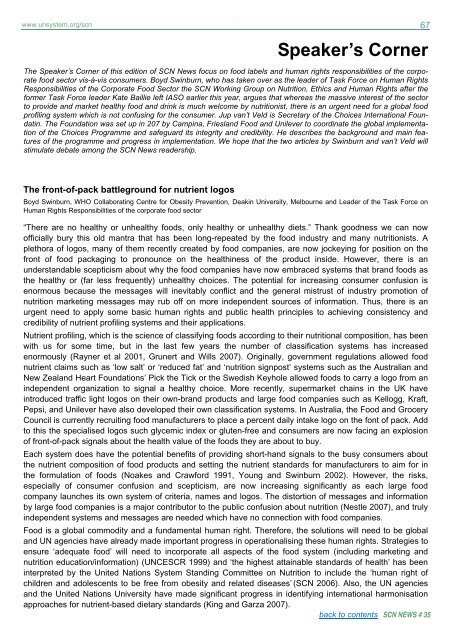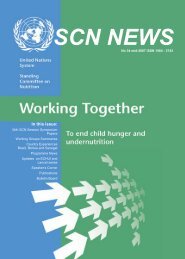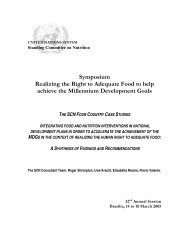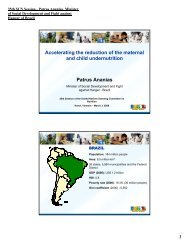Universal Salt Iodization (USI) - FTP Directory Listing
Universal Salt Iodization (USI) - FTP Directory Listing
Universal Salt Iodization (USI) - FTP Directory Listing
- No tags were found...
You also want an ePaper? Increase the reach of your titles
YUMPU automatically turns print PDFs into web optimized ePapers that Google loves.
www.unsystem.org/scn 67Speaker’s CornerThe Speaker’s Corner of this edition of SCN News focus on food labels and human rights responsibilities of the corporatefood sector vis-à-vis consumers. Boyd Swinburn, who has taken over as the leader of Task Force on Human RightsResponsibilities of the Corporate Food Sector the SCN Working Group on Nutrition, Ethics and Human Rights after theformer Task Force leader Kate Baillie left IASO earlier this year, argues that whereas the massive interest of the sectorto provide and market healthy food and drink is much welcome by nutritionist, there is an urgent need for a global foodprofiling system which is not confusing for the consumer. Jup van’t Veld is Secretary of the Choices International Foundatin.The Foundation was set up in 207 by Campina, Friesland Food and Unilever to coordinate the global implementationof the Choices Programme and safeguard its integrity and credibility. He describes the background and main featuresof the programme and progress in implementation. We hope that the two articles by Swinburn and van’t Veld willstimulate debate among the SCN News readership.The front-of-pack battleground for nutrient logosBoyd Swinburn, WHO Collaborating Centre for Obesity Prevention, Deakin University, Melbourne and Leader of the Task Force onHuman Rights Responsibilities of the corporate food sector“There are no healthy or unhealthy foods, only healthy or unhealthy diets.” Thank goodness we can nowofficially bury this old mantra that has been long-repeated by the food industry and many nutritionists. Aplethora of logos, many of them recently created by food companies, are now jockeying for position on thefront of food packaging to pronounce on the healthiness of the product inside. However, there is anunderstandable scepticism about why the food companies have now embraced systems that brand foods asthe healthy or (far less frequently) unhealthy choices. The potential for increasing consumer confusion isenormous because the messages will inevitably conflict and the general mistrust of industry promotion ofnutrition marketing messages may rub off on more independent sources of information. Thus, there is anurgent need to apply some basic human rights and public health principles to achieving consistency andcredibility of nutrient profiling systems and their applications.Nutrient profiling, which is the science of classifying foods according to their nutritional composition, has beenwith us for some time, but in the last few years the number of classification systems has increasedenormously (Rayner et al 2001, Grunert and Wills 2007). Originally, government regulations allowed foodnutrient claims such as ‘low salt’ or ‘reduced fat’ and ‘nutrition signpost’ systems such as the Australian andNew Zealand Heart Foundations’ Pick the Tick or the Swedish Keyhole allowed foods to carry a logo from anindependent organization to signal a healthy choice. More recently, supermarket chains in the UK haveintroduced traffic light logos on their own-brand products and large food companies such as Kellogg, Kraft,Pepsi, and Unilever have also developed their own classification systems. In Australia, the Food and GroceryCouncil is currently recruiting food manufacturers to place a percent daily intake logo on the font of pack. Addto this the specialised logos such glycemic index or gluten-free and consumers are now facing an explosionof front-of-pack signals about the health value of the foods they are about to buy.Each system does have the potential benefits of providing short-hand signals to the busy consumers aboutthe nutrient composition of food products and setting the nutrient standards for manufacturers to aim for inthe formulation of foods (Noakes and Crawford 1991, Young and Swinburn 2002). However, the risks,especially of consumer confusion and scepticism, are now increasing significantly as each large foodcompany launches its own system of criteria, names and logos. The distortion of messages and informationby large food companies is a major contributor to the public confusion about nutrition (Nestle 2007), and trulyindependent systems and messages are needed which have no connection with food companies.Food is a global commodity and a fundamental human right. Therefore, the solutions will need to be globaland UN agencies have already made important progress in operationalising these human rights. Strategies toensure ‘adequate food’ will need to incorporate all aspects of the food system (including marketing andnutrition education/information) (UNCESCR 1999) and ‘the highest attainable standards of health’ has beeninterpreted by the United Nations System Standing Committee on Nutrition to include the ‘human right ofchildren and adolescents to be free from obesity and related diseases’ (SCN 2006). Also, the UN agenciesand the United Nations University have made significant progress in identifying international harmonisationapproaches for nutrient-based dietary standards (King and Garza 2007).back to contents SCN NEWS # 35







